wiper blades CHEVROLET BLAZER 1993 Owners Manual
[x] Cancel search | Manufacturer: CHEVROLET, Model Year: 1993, Model line: BLAZER, Model: CHEVROLET BLAZER 1993Pages: 386, PDF Size: 20.7 MB
Page 102 of 386
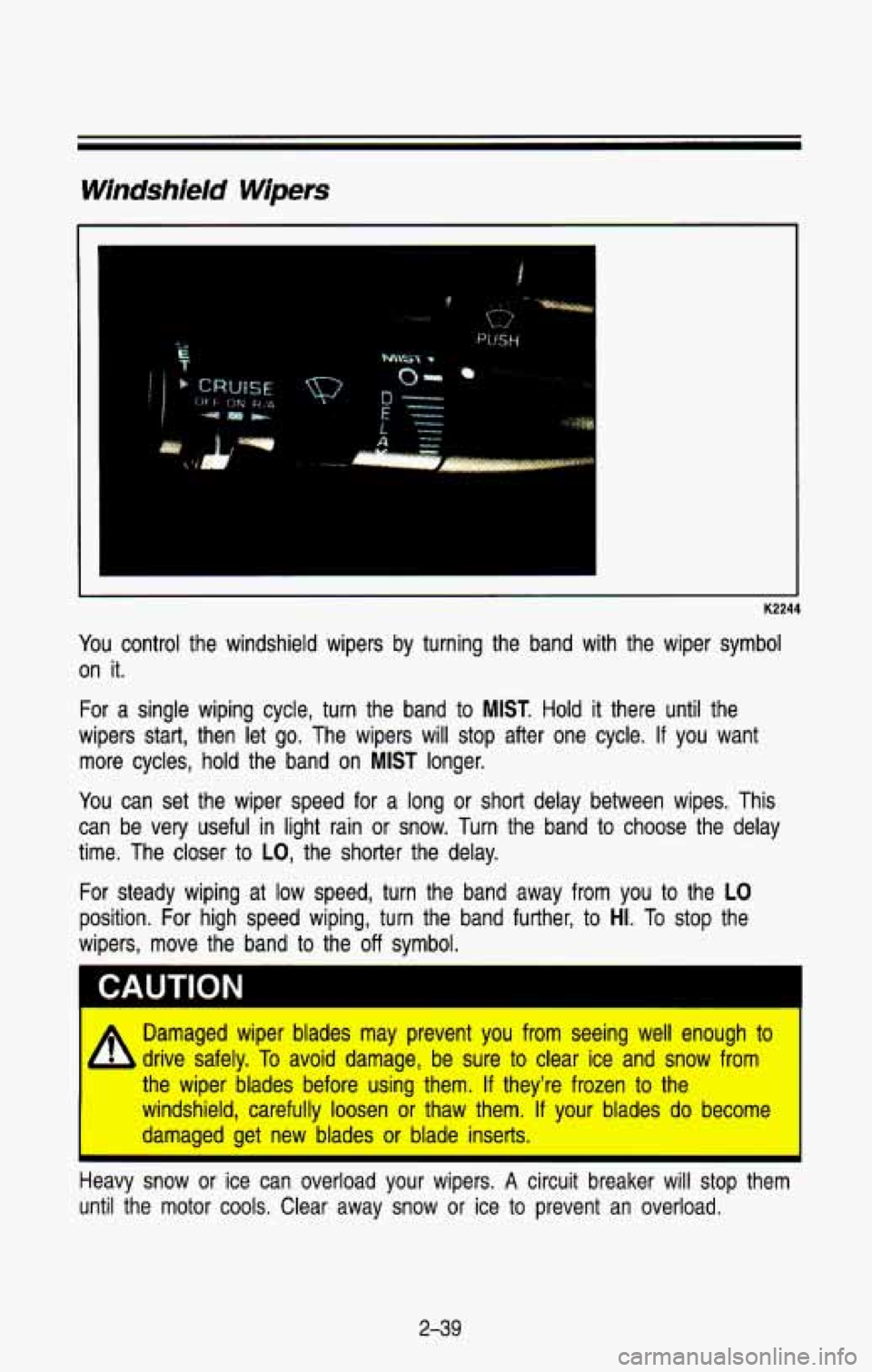
Windshield Wipers
K2244
You control the windshield wipers by turning the band with the wiper symbol
on it.
For a single wiping cycle, turn the band to MIST. Hold it there until the
wipers start, then let go. The wipers will stop after one cycle. If you want
more cycles, hold the band on
MIST longer.
You can set the wiper speed for a long or short delay between wi\
pes. This
can be very useful in light rain
or snow. Turn the band to choose the delay
time. The closer to
LO, the shorter the delay.
For steady wiping at low speed, turn the band away from you to the
LO
position. For high speed wiping, turn the band further, to HI. To stop the
wipers, move the band to the
off symbol.
A
Damaged wiper blades may prevent you from seeing well enough to
drive safely. To avoid damage, be sure to clear ice and snow from
the wiper blades before using them.
If they’re frozen to the
windshield, carefully loosen
or thaw them. If your blades do become
damaged get new blades
or blade inserts.
Heavy snow or ice can overload your wipers.
A circuit breaker will stop them
until the motor cools. Clear away snow
or ice to prevent an overload.
2-39
Page 204 of 386
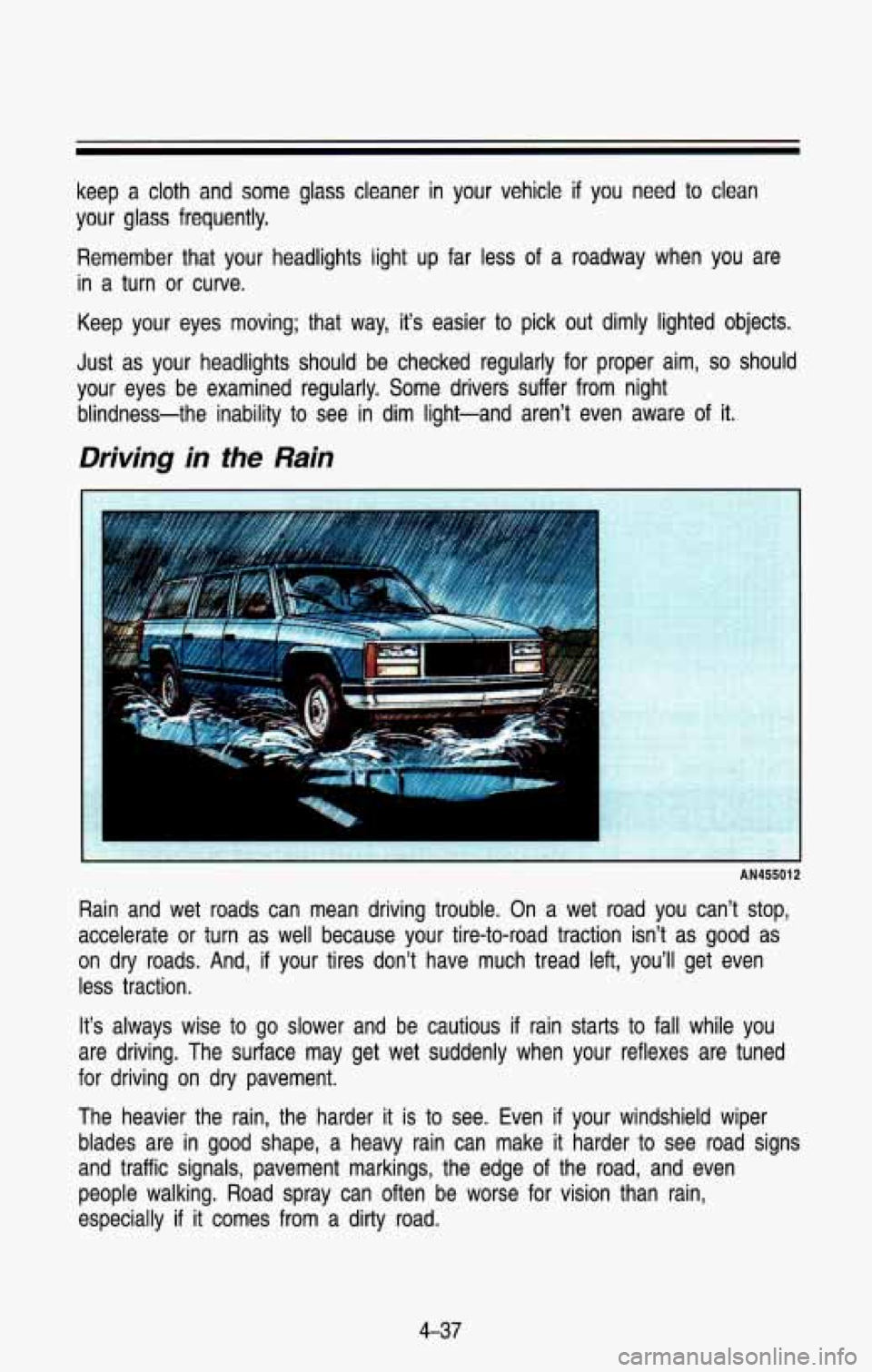
keep a cloth and some glass cleaner in your vehicle if you need to clean
your glass frequently.
Remember that your headlights light up far less of a roadway when you are
in a turn or curve.
Keep your eyes moving; that way, it’s easier to pick out dimly lighted objects.
Just as your headlights should be checked regularly for proper \
aim,
so should
your eyes be examined regularly. Some drivers suffer from night\
blindness-the inability to see in dim light-and aren’t even aware of it.
Driving in the Rain
AN455012
Rain and wet roads can mean driving trouble. On a wet road y\
ou can’t stop,
accelerate or turn as well because your tire-to-road traction isn’t as good as
on dry roads. And,
if your tires don’t have much tread left, you’ll get even
less traction.
It’s always wise to go slower and be cautious
if rain starts to fall while you
are driving. The surface may get wet suddenly when your reflex\
es are tuned
for driving on
dry pavement.
The heavier the rain, the harder it is to see. Even
if your windshield wiper
blades are in good shape, a heavy rain can make it harder to see road signs
and traffic signals, pavement markings, the edge of the road, and even
people walking. Road spray can often be worse for vision than rain,
especially
if it comes from a dirty road.
4-37
Page 212 of 386
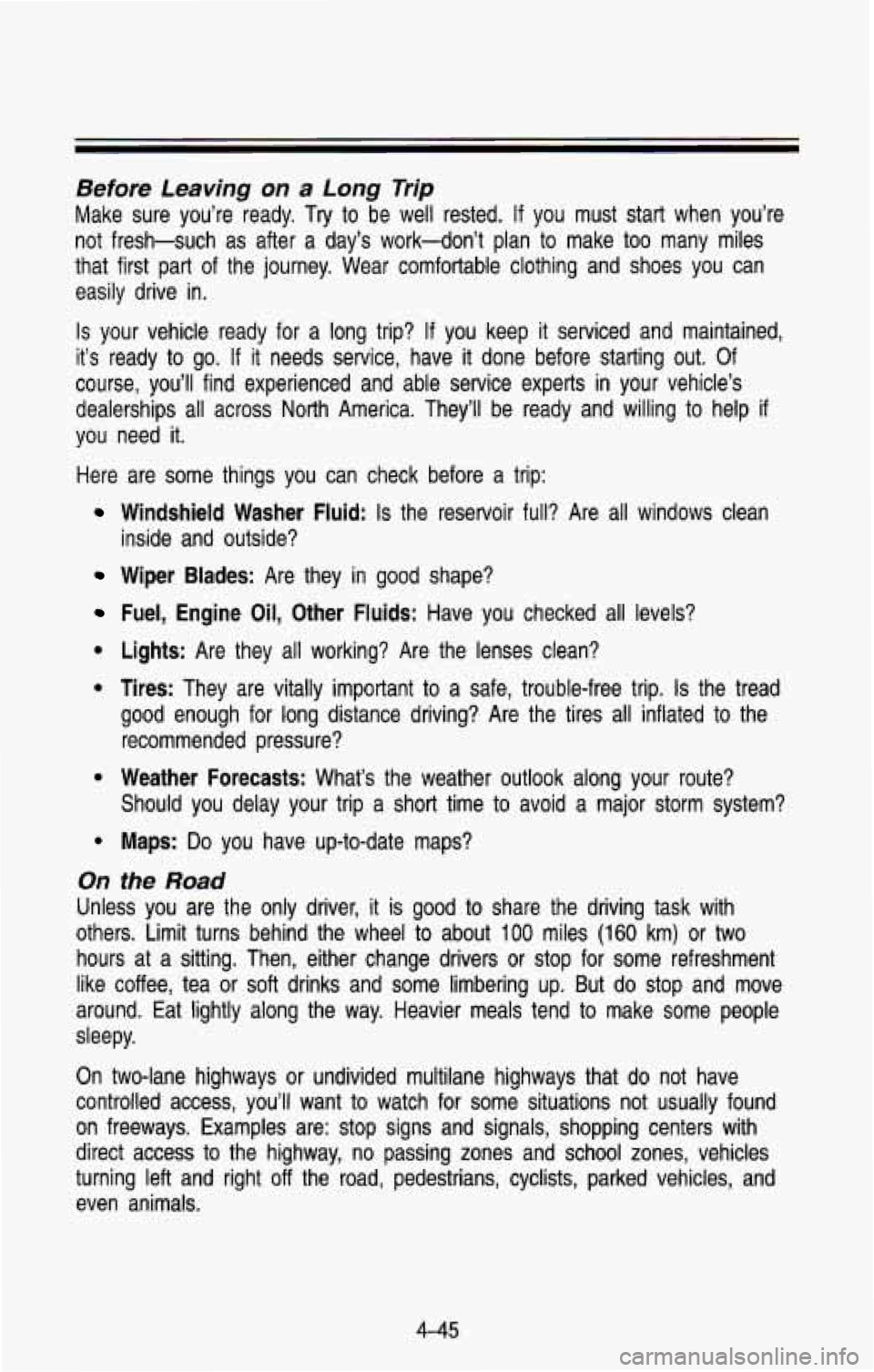
Before Leaving on a Long Trip
Make sure you’re ready. Try to be well rested. If you must start when you’re
not fresh-such as after a day’s work-don’t plan to make too many miles
that first part of the journey. Wear comfortable clothing and shoes you can
easily drive in.
Is your vehicle ready for a long trip? If you keep it serviced and maintained,
it’s ready to go. If it needs service, have it done before starting out. Of
course, you’ll find experienced and able service experts
in your vehicle’s
dealerships all across North America. They’ll be ready and w\
illing to help
if
you need it.
Here are some things you can check before a trip:
e
e
On
Windshield Washer Fluid: Is the reservoir full? Are all windows clean
inside and outside?
Wiper Blades: Are they in good shape?
Fuel, Engine Oil, Other Fluids: Have you checked all levels?
Lights: Are they all working? Are the lenses clean?
Tires: They are vitally important to a safe, trouble-free trip. Is the tread
good enough for long distance driving? Are the tires all inflated to the
recommended pressure?
Weather Forecasts: What’s the weather outlook along your route?
Should you delay your trip a short time to avoid a major storm system?
Maps: Do you have up-to-date maps?
the Road
Unless you are the only driver, it is good to share the driving task with
others. Limit turns behind the wheel to about
100 miles (160 km) or two
hours at a sitting. Then, either change drivers or stop for s\
ome refreshment
like coffee, tea or soft drinks and some limbering up. But do stop and move
around. Eat lightly along the way. Heavier meals tend
to make some people
sleepy.
On two-lane highways or undivided multilane highways that do not have
controlled access, you’ll want to watch for some situations not usually found
on freeways. Examples are: stop signs and signals, shopping cen\
ters with
direct access to the highway, no passing zones and school zones, vehicles
turning left and right
off the road, pedestrians, cyclists, parked vehicles, and
even animals.
4-45
Page 326 of 386
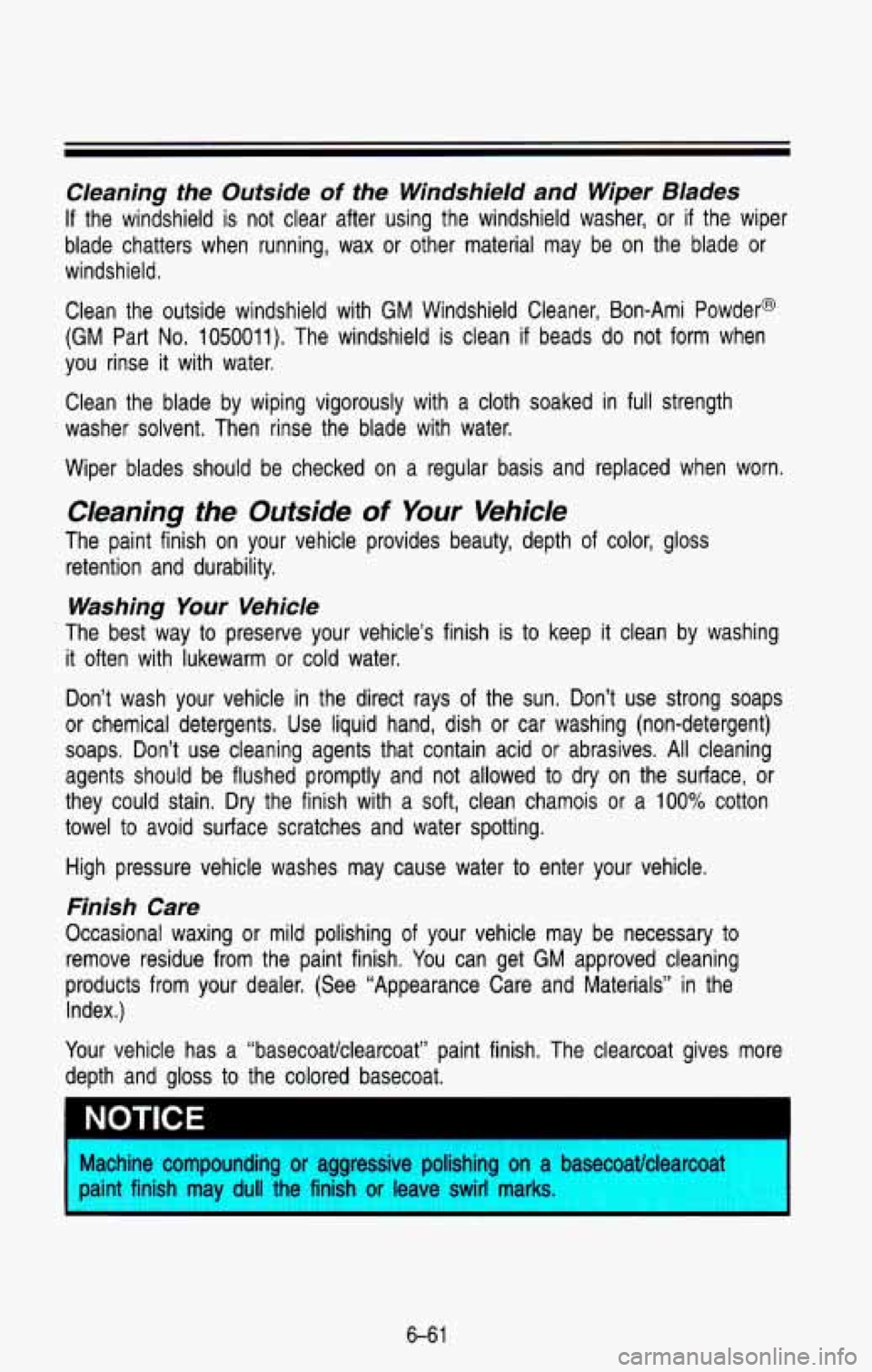
Cleaning the Outside of the Windshield and Wiper Blades
If the windshield is not clear after using the windshield washer, or if the wiper
blade chatters when running, wax or other material may be on the blade or
windshield,
Clean the outside windshield with
GM Windshield Cleaner, Bon-Ami Powder@
(GM Part No. 1050011). The windshield is clean if beads do not form when
you rinse it with water.
Clean the blade by wiping vigorously with a cloth soaked in full strength
washer solvent. Then rinse the blade with water.
Wiper blades should be checked on a regular basis and replaced\
when worn.
Cleaning the Outside of Your Vehicle
The paint finish on your vehicle provides beauty, depth of color, gloss
retention and durability.
Washing Your Vehicle
The best way to preserve your vehicle’s finish is to keep it clean by washing
it often with lukewarm or cold water.
Don’t wash your vehicle in the direct rays
of the sun, Don’t use strong soaps
or chemical detergents. Use liquid hand, dish or car washing (non-detergent)
soaps. Don’t use cleaning agents that contain acid
or abrasives. All cleaning
agents should be flushed promptly and not allowed to dry on t\
he surface, or
they could stain. Dry the finish with a soft, clean chamois or a
100% cotton
towel to avoid surface scratches and water spotting.
High pressure vehicle washes may cause water to enter your vehicle.
Finish Care
Occasional waxing or mild polishing of your vehicle may be necessary to
remove residue from the paint finish. You can get GM approved cleaning
products from your dealer. (See “Appearance Care and Materia\
ls” in the
Index.)
Your vehicle has a “basecoatlclearcoat” paint finish. The clearcoat gives more
depth and
gloss to the colored basecoat.
Machine compounding
or aggressive polishing on a basecoatlctearcoat I f
paint finish may dull the finish or leave swirl marks.
6-6 1
Page 382 of 386
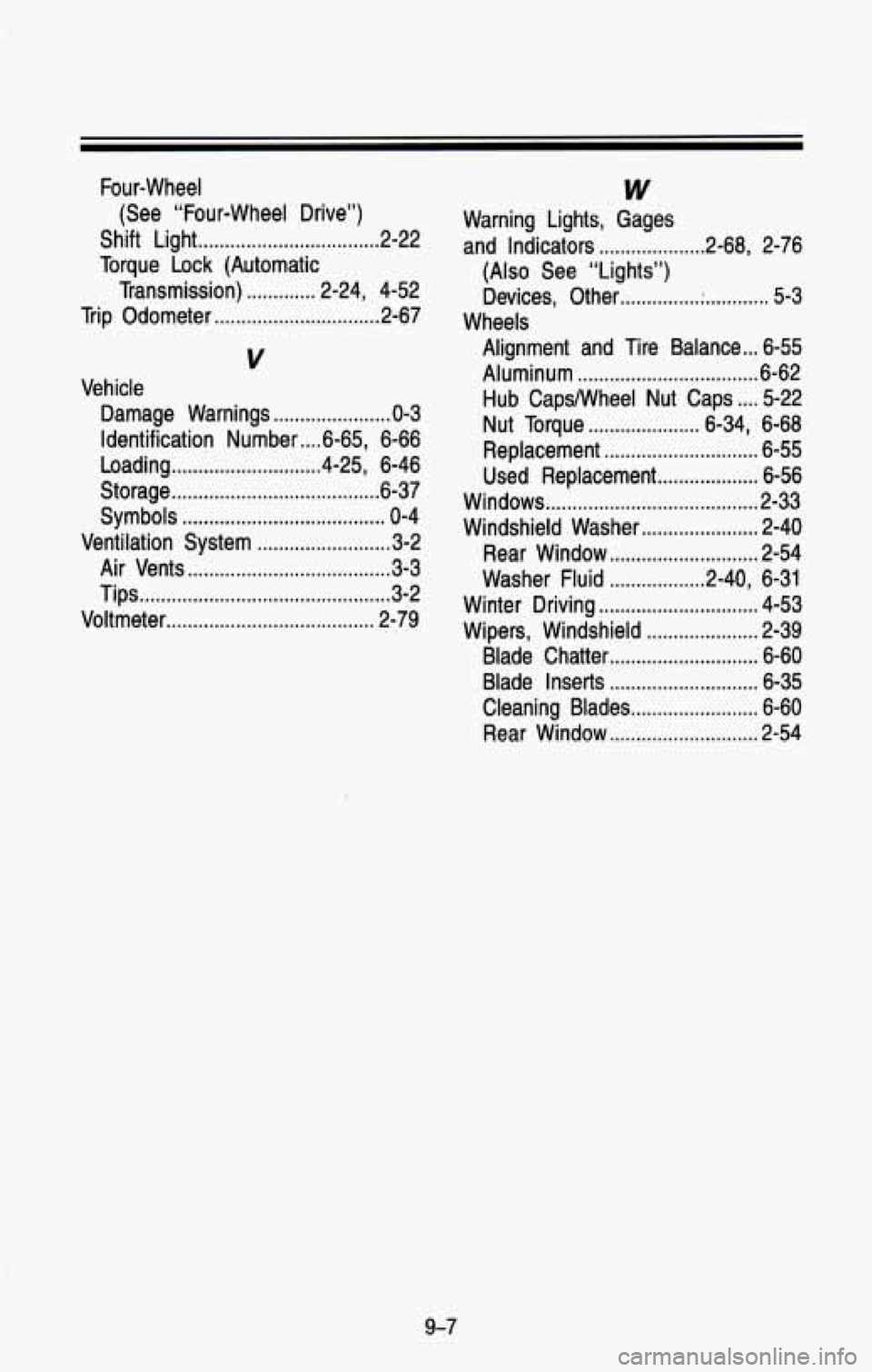
Four-wheel
Shift Light
.................................. 2-22
Torque Lock (Automatic
Transmission)
............. 2.24. 4-52
Trip Odometer
............................... 2-67
V
Damage Warnings ...................... 0-3
Identification Number
.... 6.65. 6-66
Loading
............................ 4.25. 6-46
Storage
....................................... 6-37
Symbols
...................................... 0-4
Ventilation System
......................... 3-2
Air Vents
...................................... 3-3
Tips
............................................... 3.2
Voltmeter
....................................... 2-79
(See “Four-Wheel
Drive”)
Vehicle
W
Warning Lights. Gages and Indicators
.................... 2.68. 2-76
(Also See “Lights”)
Devices. Other
............... ; ............ 5-3
Alignment and Tire Balance
... 6-55
Aluminum
.................................. 6-62
Hub CapsNheel Nut Caps
.... 5-22
Nut Torque
..................... 6.34. 6-68
Replacement
............................. 6-55
Used Replacement
................... 6-56
Windows
........................................ 2-33
Windshield Washer
...................... 2-40
Rear Window
............................ 2-54
Washer Fluid
.................. 2.40. 6-31
Winter Driving
.............................. 4-53
Wipers. Windshield
..................... 2-39
Blade Chatter
............................ 6-60
Blade Inserts
............................ 6-35
Cleaning Blades
........................ 6-60
Rear Window
............................ 2-54
Wheels
9-7